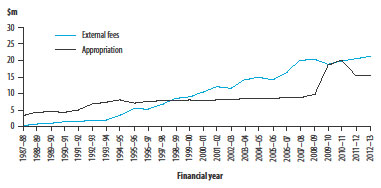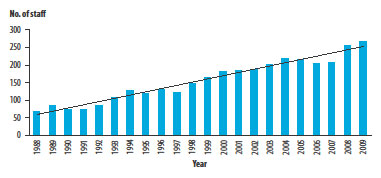Summary
Who we are
The main functions of the Australian Institute of Health and Welfare (AIHW) are to collect, analyse and disseminate health-related and welfare-related information and statistics. These functions are specified in s. 5 of the Australian Institute of Health and Welfare Act 1987 (AIHW Act) and require information to be developed, collected and reported in the following subject matter areas:
- health
- aged care services
- child care services (including services designed to encourage or support participation by parents in educational courses, training and the labour force)
- services for people with disabilities
- housing assistance (including programs designed to provide access to crisis accommodation in the short term)
- child welfare services (including, in particular, child protection and substitute care services); and
- other community services.
Across these subject matters, the AIHW provides authoritative, timely information and analysis to governments and the community. A total of 66 data collections are managed within the Institute. An important part of this role is the development, maintenance and promotion of information standards to ensure that data are nationally consistent and appropriate for purpose.
The AIHW produces many public reports and actively promotes its work in the community.
How we are governed
The AIHW was established as a statutory authority in 1987 by the Australian Institute of Health Act 1987 to report to the nation on the state of its health. In 1992, the role and functions of the then Australian Institute of Health were expanded to include welfare-related information and statistics, making it the Australian Institute of Health and Welfare. The Act is now titled the Australian Institute of Health and Welfare Act 1987 (Appendix 2).
The Act establishes the Board as the governing body, with the role and composition of the Board specified in s. 8(1) of the Act. The AIHW Board is accountable to the Parliament of Australia through the Minister for Health and Ageing.
Responsible minister
As at 30 June 2009

The Hon Nicola Roxon, MP
Minister for Health and Ageing
Our accountability framework
The AIHW's outcome, as stated in the 2008–09 Portfolio Budget Statements for the Health and Ageing portfolio, is 'Better health and wellbeing for Australians through better health and welfare statistics and information'.
The AIHW has one output group: 'Develop, collect, analyse and report high-quality national health and welfare information and statistics for governments and the community'. See Chapter 2 Performance for more information.
The AIHW operates under the Commonwealth Authorities and Companies Act 1997. It prepares a set of annual financial statements as required by the Finance Minister's Orders, made under the Commonwealth Authorities and Companies Act 1997 and the Australian Accounting Standards. These financial statements are audited by the Australian National Audit Office. The detailed financial statements and the auditor's report are contained in Appendix 1.
How we are funded
In 2008–09 the AIHW received 29% of its funding as an annual appropriation from the Australian Government.
Over the years, the annual appropriation has been increasingly supplemented by funding from Australian and state government departments and agencies for work on specific projects. Most funding is now for specific projects. The deliverables and funding for each of these projects are negotiated with the funder.
Summary of financial performance
The AIHW's financial results against the 2008–09 Estimates contained in the 2009–10 Portfolio Budget Statements and the actual results for 2007–08 are summarised in Table 1.
In 2008–09 the AIHW achieved a small surplus of $139,000 compared to deficits in the previous two years. The AIHW's appropriation funding from the Australian Government was $9.325 million, an increase of 7.5% over the previous financial year. This increase was mainly due to new funding for the AIHW's role in implementing the COAG federal financial framework, received late in the financial year.
External fee revenue increased by 10% over the previous financial year to its highest ever level. Most of this income came from Australian Government departments.
Total expenditure increased in line with the growth in revenue. Employee expenses include a one-off charge of $159,000 for the increase in long service leave liabilities caused by the fall in the 10 year Government bond rate since 30 June 2008. Other expenditure reduced mainly because the AIHW paid a contractor for a large survey in 2007–08, which did not recur 2008–09.
Trend analysis
The proportion of AIHW's income from appropriation has decreased from almost 100% in 1987–88 to 29% in 2008–09. In the May 2009 Federal Budget the AIHW received a significant increase in appropriation funding for the next four years, largely for work related to COAG's federal financial framework reforms.
The AIHW's revenue from appropriation and external fees since the creation of the AIHW in 1987 and budgeted income for the next three years is shown in Figure 1.
Our publications
Information and data are disseminated in a variety of ways, including hard copy publications, website publications and guidelines and specific-purpose material placed on the website. All publications are available free of charge from the website. From July 2009, these will be available in accessible format for the vision-impaired. In 2008–09 the AIHW released 152 publications.
In alternate years the AIHW is required by its Act to publish Australia's health and Australia's welfare, both of which are key national resources for these major areas. In addition, the AIHW publishes a comprehensive report in conjunction with the Australian Bureau of Statistics on the health and welfare of Australia's Aboriginal and Torres Strait Islander peoples.
The next Australia's welfare will be published in November 2009. The next Australia's health is due to be published in June 2010 and is in the developmental stage.
Our people
At the end of the reporting period, there were 269 staff employed at the AIHW, equating to a full time equivalent of 237.4. Figure 2 shows that staff numbers increased from 257 to 269 over the year to June 2009, an increase of 12 staff. This was largely as a result of the increase in full-time ongoing employment.
Staff have a high level of university qualifications and there is a strong graduate intake program every year. Staff numbers are increasing and particular attention is paid to good induction for new starters. A regular learning and development program is in place, supported under the Certified Agreement with all staff. The AIHW provides a positive and rewarding work environment for staff.
A Reconciliation Action Plan was endorsed by Reconciliation Australia and launched on 11 June 2009 (see page 61).
Key relationships and engagement
To carry out its functions, the AIHW must identify and meet the information needs of governments and the community. Much of the information is sensitive and cannot be used without the permission of the various parties who provide it.
Within this environment, the AIHW has developed a strongly collaborative approach to its work, balancing the need for objectivity against the development of engagement and trust.
As part of the Health and Ageing portfolio, the AIHW works closely with the Australian Government Department of Health and Ageing (DoHA), and substantial work is contracted from the Department. Other Australian Government Departments also look to the AIHW for assistance with specific information needs—these include the Department of Families, Housing, Community Services and Indigenous Affairs (FaHCSIA), the Department of Veterans' Affairs (DVA) and the Department of Education, Employment and Workplace Relations (DEEWR).
Close working relationships with state and territory governments are critical to the development of nationally-consistent and comparable information across jurisdictions. This is governed through processes established under the relevant Ministerial Councils in the areas covered by AIHW's statutory functions. The AIHW provides secretariats for national information governance committees where national data standards are agreed, authorised and registered by the AIHW.
The Australian Bureau of Statistics (ABS) is a key partner and there is regular interaction with staff across a range of subjects. The Australian Statistician is a member of the Institute's Board.
Consultation with a broad range of players underpins AIHW's ongoing work. The list of national committees in which AIHW participates as chair or secretariat (Appendix 9) illustrates the depth and breadth of engagement.
The Institute's program of work in Indigenous health and welfare information is carried out in close collaboration with Indigenous advisors. AIHW continued to support the National Advisory Group on Aboriginal and Torres Strait Islander Health Information and Data (NAGATSIHID) and participated in the National Aboriginal and Torres Strait Islander Health Officials Network (NATSIHON), to ensure that work in the Indigenous area is shaped by relevant policy.
Collaborations and partnerships
The AIHW has funded work plans and data sharing agreements with a number of universities to facilitate collaboration and to draw on their expertise in specialist areas of data and information. In effect, this creates AIHW units at various universities. Throughout 2008–09 there were five such arrangements, providing AIHW specialist statistical units in injury, asthma monitoring, dental, perinatal and general practice statistics based at five different locations. Such collaborations extend the range of skills available to the AIHW and enhance its capacity to perform its functions across a broader range of subject matter.
In addition the AIHW also had a number of data sharing agreements with specialist centres across Australia. These agreements do not involve funding or work plan oversight, but allow use of Institute data by specialist units, within the protection of the AIHW Act's privacy provisions, in order to facilitate information development. In 2008–09 a data sharing agreement was in place with the National Centre for Classification in Health at the University of Sydney. This agreement provided a basis for the Centre to undertake its role in the updating and implementation of the ICD-10-AM (Australian version of the International Classification of Diseases).
A data sharing agreement with the National Centre for Classification in Health (Brisbane) supports the use of health classifications in mortality, hospitals and other data sets, and associated international work. Similar data sharing arrangements were in place with the National Centre for Immunisation Research and Surveillance and the National Centre in HIV Epidemiology and Clinical Research.
The AIHW also works closely with other government agencies. These include the Australian Safety and Quality in Healthcare Commission and the Australian Institute of Family Studies.
| Actual 2008–09 $'000 |
Estimates |
Actual 2007–08 $'000 |
|
|---|---|---|---|
| Revenue | |||
| Appropriation revenue | 9,325 | 9,325 | 8,678 |
| Total revenue from other sources | 23,022 | 21,070 | 20,922 |
| Total revenue | 32,347 | 30,395 | 29,600 |
| Expenditure | |||
| Employees | 21,860 | 21,344 | 18,437 |
| Other expenditure | 10,348 | 9,508 | 11,927 |
| Total expenditure | 32,208 | 30,852 | 30,364 |
| Surplus / (deficit) | 139 | (457) | (764) |
Figure 1: Revenue history and projections, 1997–98 to 2012–13

Figure 2: Total staff numbers 1988–2009




